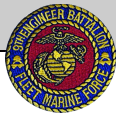
|
MAY 23RD, 1968, MARKS SECOND ANNIVERSARY IN VIETNAM
CHU LAI - "One of the primary reasons for the United States being in Vietnam is to help rebuild the nation," commented LtCol. WE. Perea (Clif¬ton, Ariz.). To help fulfill this mission, Col. Perea directs a task force of over 1,000 highly trained 9th Engineer Bn. Marines operating more than $10 million worth of equipment. Highway engineers maintaining 47 miles of road anywhere in the States would have problems facing them, but hardly the same ones that face the 1st Marine Division's 9th Engineers in Vietnam.
The Chu Lai-based 9th Engineers have the massive respon¬sibility of keeping open and passable the 47.6 mile stretch of Vietnam's Route 1 from Chu Lai north to the Cau Lau River. Their highway segment is a relatively straight stretch of road that runs along the coastal flatlands. The terrain is criss-crossed by sand flats and rice paddies. Since their arrival in Vietnam on May 23, 1966, the 9th Engi¬neers have turned Route 1 from an impassable road into nearly 50 miles of two-lane, gravel-based highway. To accomplish this they had to build or repair 41 bridges and 97 culverts. The engineers' trucks, hauling more than 8,000 cubic yards of crushed rock and earth a month, have built up the road from a virtual towpath into a Vietnamese "super highway." "This is an engineer's way," said Col. Perea. "By opening and upgrading the highway we help the Vietnamese economy. Commerce is allowed to flow freely and quickly between the different villages and towns." While military operations by the Marines and Army have virtually eliminated enemy interference with military convoys and commercial traffic along Route 1 during daylight hours, there are still numerous mining incidents and sabotaging of bridges and culverts during the night. Eight mine sweep teams are sent out daily from the 9th Engineers' company base camps located at various positions along the road. After the mine sweep is finished, the road is opened and the graders, dump trucks and other heavy road equipment swing into action. Mines planted along the segment of highway maintained by "Charlie" Co. are extremely difficult to locate, according to 1st Lt. Rick G. Ericson, 26, (Ames, Iowa), the company commander. "The Viet Cong are planting most of their mines directly over the metal culverts we've put in," noted Ericson. "Our mine detectors are sensitive to any type of metal and cannot distinguish the difference between the culvert alone, and one with a mine buried over it." To counter this problem, the engineers make a detailed search and probe of the highway surface passing over the culverts. During a recent six month period 9th Engineer Bn. mine sweep teams located and re¬moved or destroyed 75 Viet Cong planted mines. In the same period nine vehicles were destroyed when they detonated mines. "We know the mines are there and we try like hell to find them, but some still go undetected," Ericson said. During their two years in country, the 9th Engineers have replaced or built 41 tactical bridges along their 47.6 mile stretch of Route 1. Because there are so many bridges it is impossible to provide night security for each one. The snaller, un-guarded ones are therefore a prime target for communist demolition teams. One particular bridge has been destroyed and rebuilt six times. To keep the traffic flowing even when bridges are destroyed, the Leathernecks have built bypasses around-all the unguarded bridges. The 11 culverts along the route are also targets of the enemy demolition teams. "We can replace destroyed culverts in about two hours," said Ericson. "The blown bridges usually take about one week to rebuild." The improvement of the roadbed itself requires fill dirt and rock to be hauled in. A fleet of dump trucks must haul the fill as far as 40 miles because the only rpck quarry in the area is at Chi Lai. When the fill is dumped it is graded and then packed down. It is essential that the road bed be built high above the rice paddies, since they are heavily flooded during the monsoon rains.. After heavy rains Route 1 appears to be a 47,6 mile stretch of bridge across a sea of water In addition to working on Route 1, the 9th Engineer Bn. provides engineering support to all free world forces in the Chu Lai area. Among these units are the U.S. Army's Americal Division, Korean Marines, Army of the Republic of Vietnam, 1st Marine Aircraft Wing, Force Logistics Command and the 1st Marine Division. Acting as a support unit, the 9th Engineers have done everything 'from accompanying night recon patrols to clearing some 6,730,000 square meters of jungle for the Army on Operation Pineapple Jungle. A float raft ferry crossing and 3,600 feet of new roads were constructed for Korean Marines engaged in Operation Dragon-Fly 2 near Hoi An. The battalion's "Delta" Co. journeyed to the DMZ to assist the 11th Engineers in building a major combat base at Ca Lu. Water purification units operated by the 9th Engineer Bn. Marines produce nearly five million gallons of potable water each month. Major vertical construction has included messhalls, airplane hangars, bunkers, helicopter landing pads, clubs, artillery pads, water towers and ammu¬nition dumps. The 9th Engineers are also engaged in an active Civil Af¬fairs program. Medical teams from the battalion operate a civilian dispensary in Tich Tay village near the battalion com¬mand post. The engineers have assisted in the construction of various schools in the area and have helped rebuild homes destroyed during the communists' Tet of¬fensive. As they move into their third year in Vietnam, the 9th Engineers continue to provide Allied forces in the Chu Lai area with the finest in engineering sup¬port.
|
|
|
|
|
